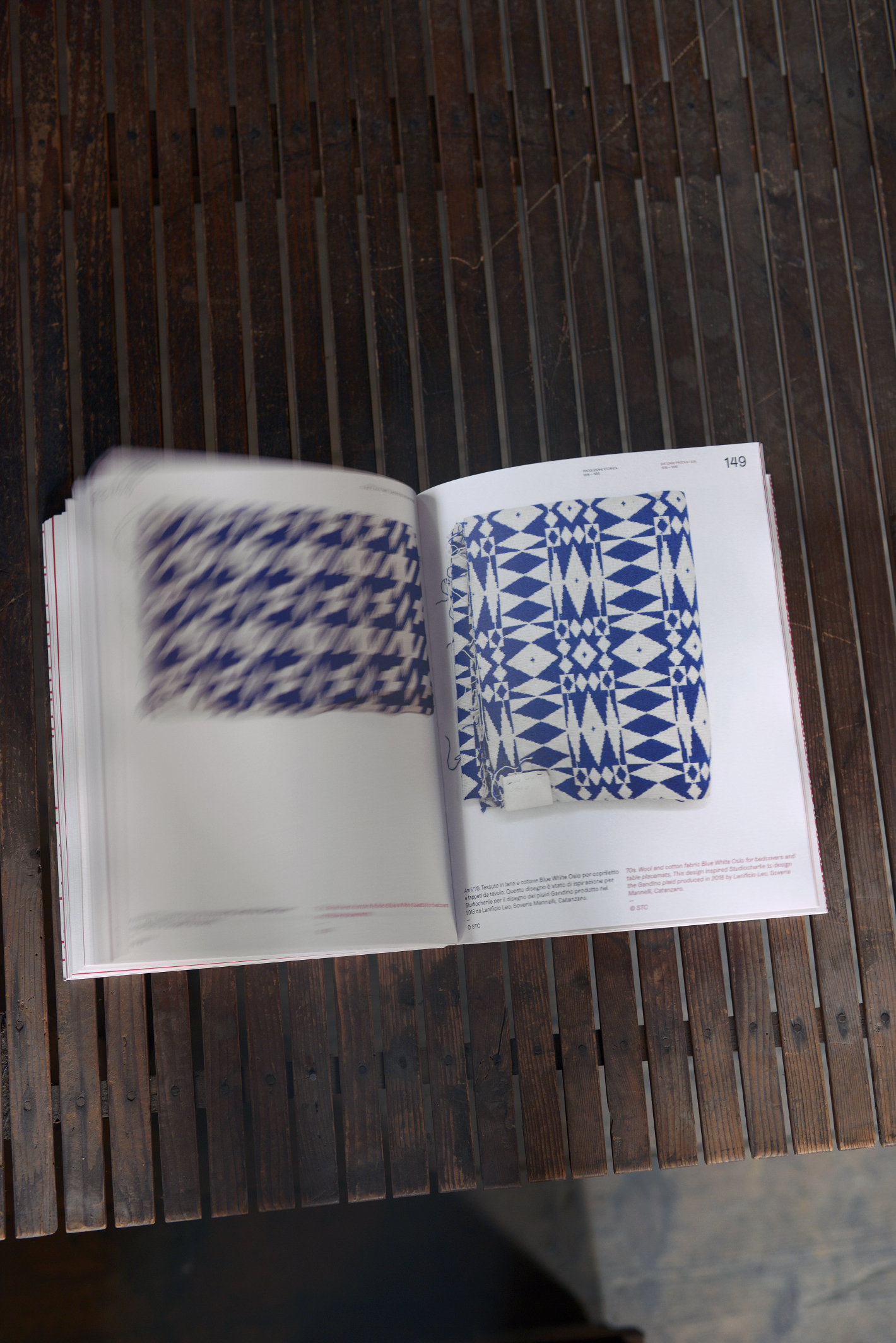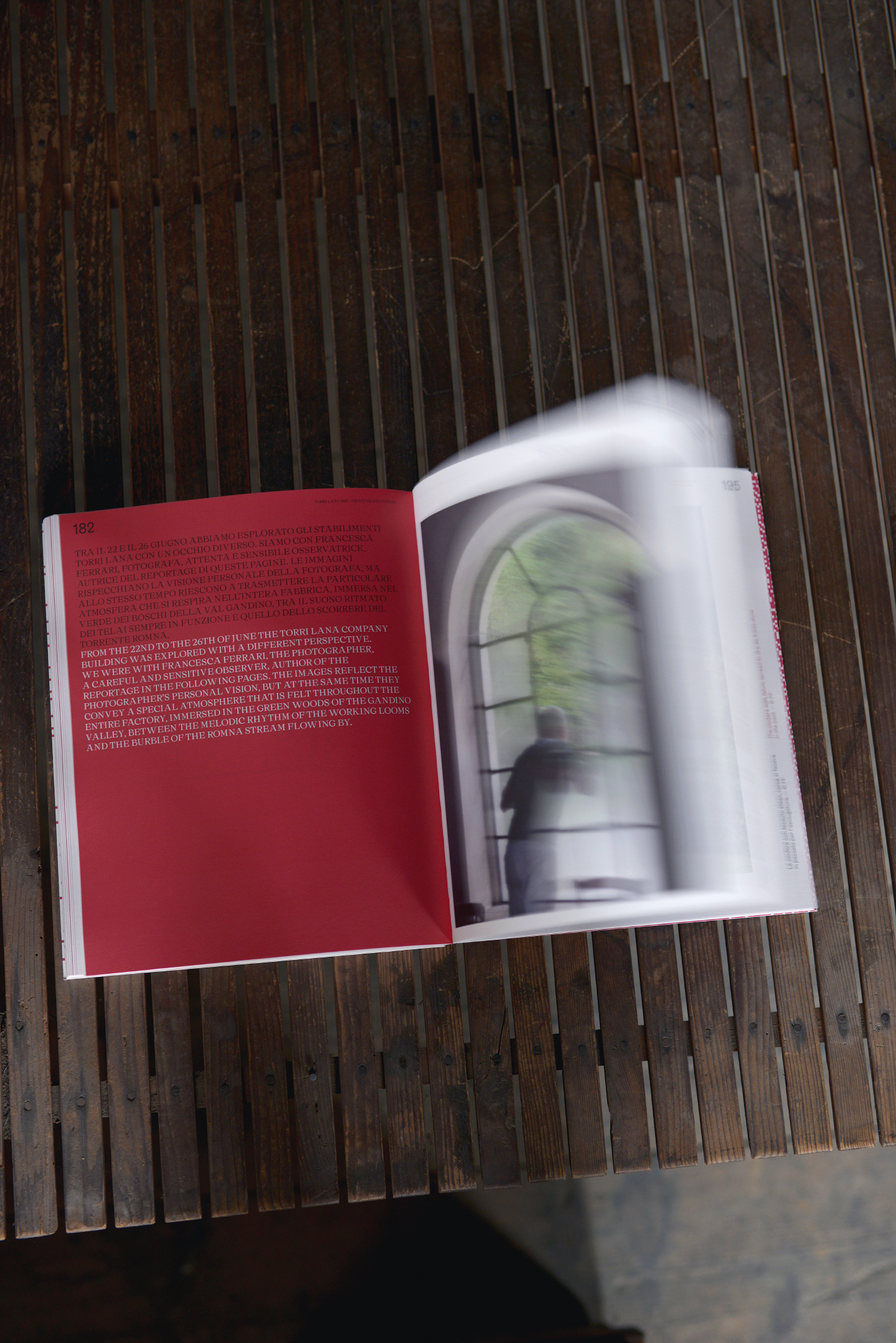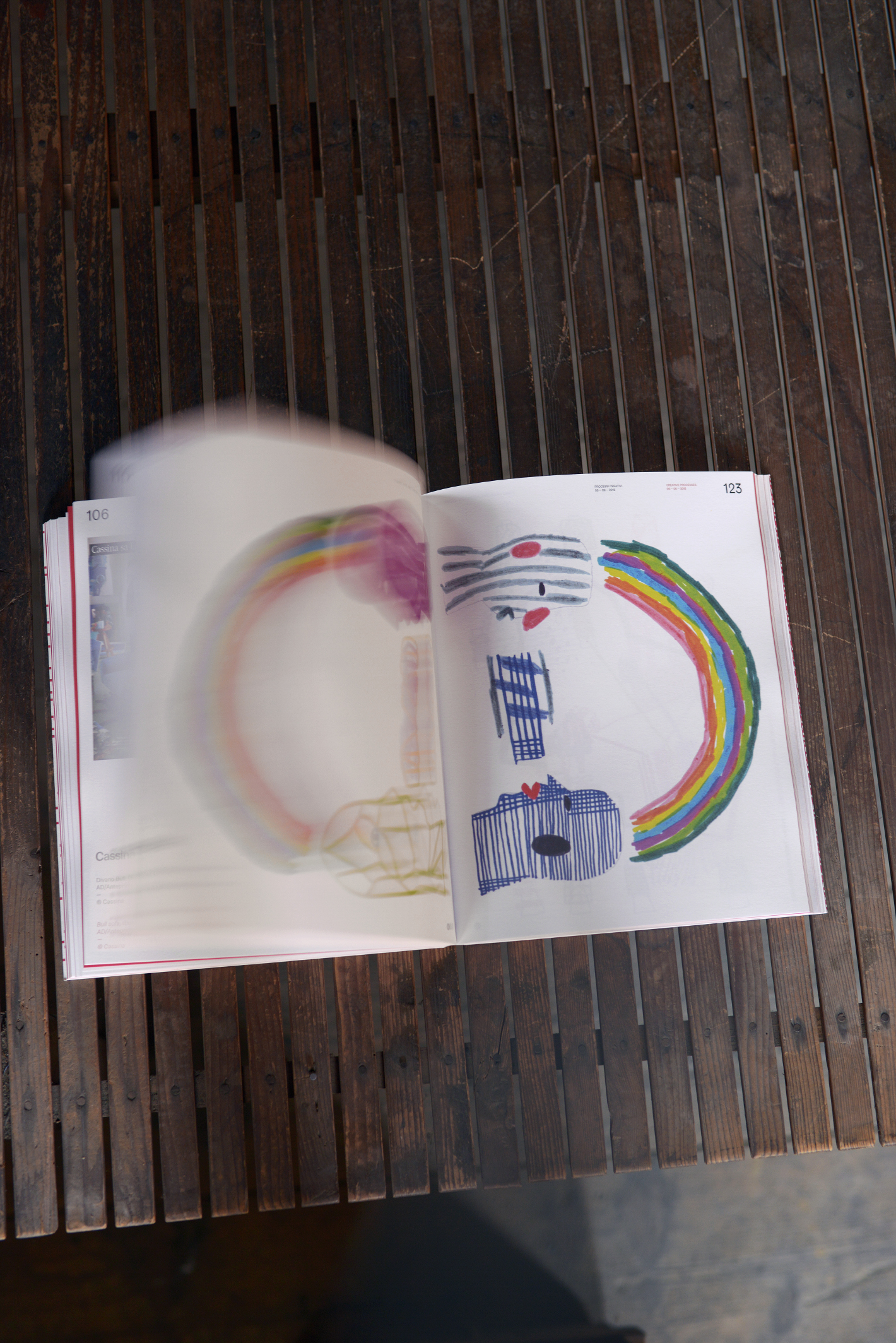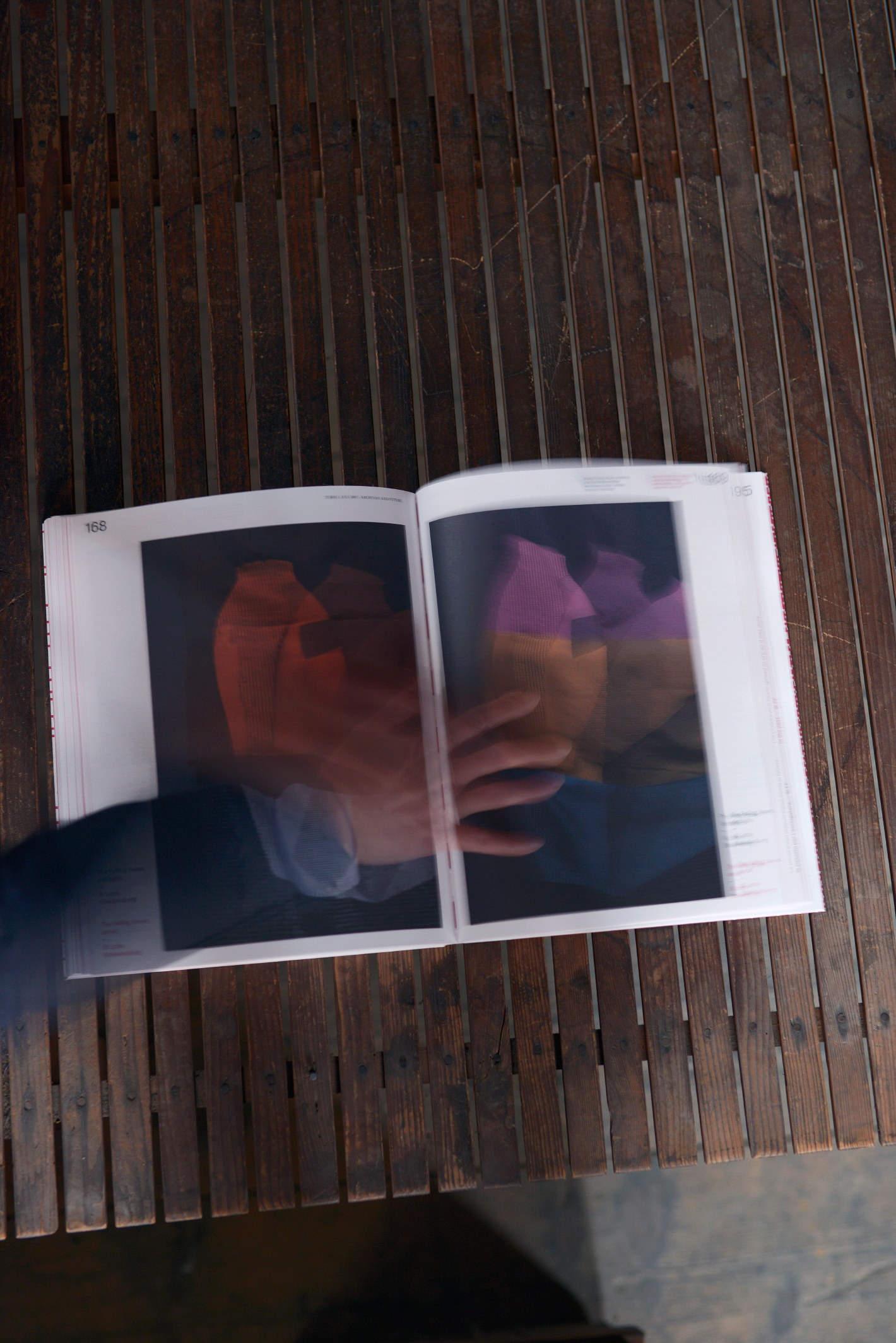



TORRI LANA 1885. ARCHIVES AND FUTURE. Libro. L’archivio Torri Lana è costituito da tessuti e documenti cartacei. All’interno di questi due gruppi si possono fare numerose suddivisioni perché esistono diversi livelli di lettura per ricostruire la lunga storia dell’azienda. Raramente i livelli possono restare ben separati l’uno dall’altro: nella maggior parte dei casi, come è normale che sia, si intersecano e si sovrappongono e ognuno di essi diventa un archivio a sé. Abbiamo cominciato ad esplorare questi numerosi archivi con la volontà di ricostruire un racconto chiaro, ma senza mai perdere la ricchezza di stimoli che deriva dall’eterogeneità dei materiali trovati. Nelle sale che raccolgono i campioni di tessuto abbiamo visto la grande produzione storica, che risale agli inizi del Novecento, quando Torri Lana produceva tessuti in lana per l’abbigliamento femminile, coperte, copriletto e vari tipi di feltri. In altri scaffali sono conservati tutti i tessuti per l’arredamento, che riguardano principalmente un arco temporale che parte dagli anni Settanta – Ottanta e arriva fino ad oggi. Nell’archivio cartaceo, tra i numerosissimi documenti, troviamo lettere scambiate con clienti e fornitori, disegni e progetti, ordini e fatture, fotografie, materiali promozionali, documenti di acquisto o cessione di proprietà, materiali pubblicitari di macchinari e documenti sulla famiglia Torri. Tanti dei materiali analizzati hanno una qualità estetica molto alta, al di là dell’importanza che singolarmente assumono per la ricostruzione di un pezzo di storia, e abbiamo deciso di farci guidare anche da questo nella selezione. Durante la ricerca è stato subito evidente che non avrebbe avuto senso seguire un ordine cronologico. I diversi livelli andavano esplorati contemporaneamente e inquadrati in un’unica visione che si sarebbe formata strada facendo. Lo stesso abbiamo fatto quando è arrivato il momento di riordinare il tutto per la pubblicazione. I materiali scelti e riprodotti in questo volume non sono schiacciati in una linea temporale, ma si presentano al lettore quasi come si sono presentati a noi. Per questo motivo il libro non ha un indice e ogni gruppo omogeneo di documenti parla la sua lingua e interpreta la storia, passata o recente, a modo proprio. Il racconto del presente produttivo dell’azienda è stato affidato a sguardi esterni, che hanno conosciuto gli stabilimenti Torri Lana proprio in occasione della realizzazione di questo progetto. Abbiamo scelto questa modalità per vedere come una realtà così ricca e sfaccettata venga percepita nell’immediatezza, e poi per raccontarla attraverso punti di vista personali e originali. Le sezioni storiche e i progetti di oggi si alternano continuamente tra le pagine del volume, perché solo nel loro insieme possono restituire il presente in modo veritiero e positivamente complesso. Il libro non contiene tutto quello che abbiamo avuto la fortuna e l’onore di scoprire e ascoltare, ma restituisce l’idea di una prima ricognizione dalla quale potranno partire ulteriori approfondimenti e ricerche. Immergersi nella storia di un sapere produttivo è un processo senza fine e uno strumento prezioso per una corretta lettura del passato; questa, insieme ai nuovi progetti e al lavoro costante di creazione e produzione, contribuisce giorno dopo giorno alla scrittura del futuro. Testo tratto dall’introduzione del libro. /// TORRI LANA 1885. ARCHIVES AND FUTURE. Book. The Torri Lana archive consists of both fabric and hard copy documents. There are many subdivisions within these two macro groups, such that several levels of interpretation can be made to reconstruct the long history of the company. The levels can hardly be separated one from the other. In most cases, as it could be expected, they intersect and overlap, each one becoming an archive in its own right. We began to explore the numerous archives in order to reconstruct a well-defined account, without ever losing the rich inspiration that comes from the heterogeneity of the information found. In the rooms where the fabric samples are stored, we have seen the great historical production of Torri Lana, which dates back to the early 20th century, when wool fabrics for women’s clothing, blankets, bedspreads and various types of wools were manufactured. Fabrics for furniture, which mainly date from the 70s and 80s to the present day on different shelves. The paper archive, among the many documents, stores correspondences from customers and suppliers, drawings and projects, orders and invoices, photographs, promotional materials, documents of purchase or transfer of property, advertising materials for machinery and documents about the Torri family. Many of the materials analysed are of excellent aesthetic quality, way beyond the importance they singularly take for the reconstruction of a piece of history, and we were also guided by this in our selection. During our research it became obvious that it would not make sense to follow a chronological order. Different levels had to be explored at the same time and framed in a single vision that would be developed along the way. We did the exact same thing when reorganizing everything for publication. The information chosen and reproduced in this volume is not crushed in a timeline, but presented to the reader almost as it was presented to us. So the book does not have an index and each homogeneous group of documents speaks its own language and interprets history, past or recent, in its own way. The story of the company’s present-day production has been entrusted to external observers, who collaborated with the Torri Lana company for the first time while we worked on this project. We decided upon this approach to see the persepition of such a rich and multifaceted reality by other observers, later recount it through these personal and original points of view. Present-day projects and historical sections alternate constantly through the pages of the book, because only as a whole can they recount the present, in a truthful and positively complex way. The book does not contain everything we have had the honour of discovering and listening to, but it does give an idea of an initial interpretation from which further in-depth studies and research can begin. Immersing yourself in the history of productive knowledge is a never ending process and a precious tool for understanding the past. This, together with new projects and constant creative work and production, contributes to the future day by day. Text taken from the introduction of the book.
TORRI LANA 1885. ARCHIVES AND FUTURE. A cura di Studiocharlie, Rubbettino Editore. Progetto Grafico Studio Eremo www.eremo.studio Fotografie Francesca Ferrari www.francesca-ferrari.com Illustrazioni Fulvia Monguzzi @Missgoffetown Traduzioni Susan Atim Ocaya, Anna Cecchini Manara 208 pagine, formato 30 x 24 cm, 400 illustrazioni e fotografie Font Camelot Gräbenbach - Good Type Foundry Chapter Carta Fedrigoni Vellum Premium White 140g Stampato da Rubbettino Print © 2018 Torri Lana 1885 www.torrilana.it © 2018 Rubbettino Editore www.rubbettino.it
TORRI LANA 1885.
ARCHIVES AND FUTURE.
By Studiocharlie, Rubbettino Editore.
Graphic Design Studio Eremo
www.eremo.studio
Photographs by Francesca Ferrari
www.francesca-ferrari.com
Illustrations by Fulvia Monguzzi
@Missgoffetown
Translations Susan Atim Ocaya, Anna Cecchini Manara
208 pages, 30 x 24 cm, 400 illustrations and photographs
Font Camelot Gräbenbach - Good Type Foundry Chapter
Paper Fedrigoni Vellum Premium White 140g
Printed by Rubbettino Print
© 2018 Torri Lana 1885
www.torrilana.it
© 2018 Rubbettino Editore
www.rubbettino.it